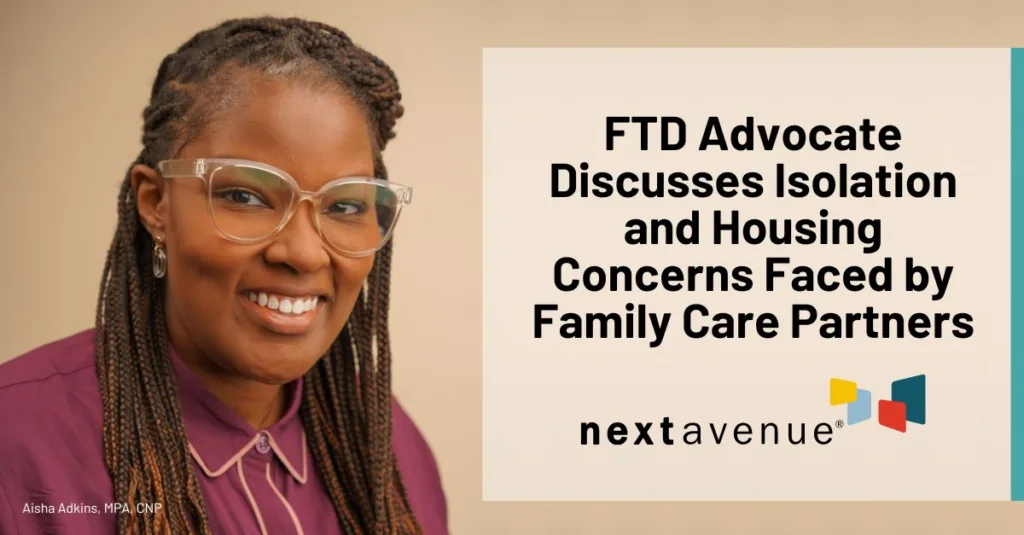FTD Advocate Discusses Isolation and Housing Concerns Faced by Family Care Partners

In a column published by the digital periodical Next Avenue, FTD advocate Aisha Adkins, MPA, CNP, discusses how care partners and people living with conditions like FTD often face overlapping hardships from loneliness and housing insecurity.
The financial impact of having a loved one diagnosed with a condition like cancer or dementia can put a strain on families, with the economic burden of FTD being twice that of Alzheimer’s disease. As Adkins highlights, millennial care partners face rising housing prices and interest rates, making purchasing their first home more challenging. The same factors put pressure on older adults who could face difficulty holding onto their homes.
Adkins also highlights the loneliness that care partners often feel, which can make it hard for someone to feel like they belong or have a community, especially if they are struggling to find a home of their own, like many millennials.
“Loneliness is a common through-line in my lived experience and many of my interactions,” Adkins writes. “Despite the availability of virtual spaces and the often-persistent presence of at least one other person in their home, many family caregivers feel something I have termed isolation. The term reflects that although many caregivers have a constant companion, they also experience a profound loss of connection.”
Adkins is well acquainted with these issues, as a millennial who has been a care partner for over a decade.
“I cared for my mother from her frontotemporal degeneration (FTD) diagnosis in 2013 until her passing in July 2023,” Adkins said. “I also care for my father, who is a stroke and prostate cancer survivor and lives with vascular dementia and stage-3 chronic kidney disease.”
Adkins is far from alone. She tells the story of fellow millennial care partner Avis Hitchcock, who has cared for their parents for six years as they both undergo treatment for cancer. Hitchcock told Adkins that their life is “beautiful and wild” as they help care for their parents and advocate for them as they receive treatment. Yet, Hitchcock highlights a disconnect between themselves and their parents.
“There’s a sense when I’m sitting with them in a room doing these things, I’m with them, and they’re with me, but…I can only imagine they feel lonely on their end because they are going through it, and I have no idea what that’s like,” Hitchcock told Adkins. “Moreover, they have no idea what I’m going through. We’re working with each other as best as possible, but there’s a divide in it. I’m having to do things for them…there’s a big surrender of having to rely on someone.”
Hitchcock says that being a care partner in the current environment is unsustainable for the mental and physical health of family members providing care, and that care partners need more support.
One potential solution lies in co-living models such as multigenerational housing. While this model has been common in many cultures throughout history, Adkins notes that Western culture defines “success” partially on home ownership. “Many people across America are living longer but cannot fiscally or mentally afford the cost of living alone,” she writes.
Multigenerational housing was crucial in helping Ariana Tellez of Minnesota get through her mother’s cancer journey, providing them with support before her mother died in 2020.
“We all had each other in our home… it was all of us and our pets,” Tellez told Adkins. “My mom was a fan of multigenerational housing, but it just made sense for us to all live together.”
But as Adkins highlights, a considerable number of people in the U.S. live alone.
“Living with a parent, partner, grandparent, child, or other family member is not an automatic solution to curbing feelings of loneliness,” Adkins writes. “Future trends are on the rise toward an intentional community where residents can depend on and build relationships with one another. “
Adkins points to the Carehaus project, which is set to provide housing for low-income older adults, disabled people, and their care partners and families. Carehaus embraces a co-living model that provides residents with shared meals, childcare, activities, classes, and practical resources. The Bridge Meadows project in Beaverton, Ore., is another co-living project creating interdependence for people living with conditions like FTD and their care partners.
Co-living may be the solution to the overlapping crises of isolation, loneliness, and the challenges of being a care partner, Adkins notes.
“[Living] in a community with care in mind has both concrete and intangible benefits that will lead to improved health outcomes,” Adkins says. “If independence is the ultimate goal, may all roads lead through interdependence. It may take a few more generations to weave caregiving and intergenerational co-living into the daily lives of aging people and their family caregivers.”
Adkins is an advocate and storyteller who works to further equitable, inclusive, and comprehensive public healthcare. She previously wrote about the disproportionate burden of caregiving for Black/African American women and the dementia care disparities faced by women of color.
You don’t have to face FTD alone; support groups are just one way you can find support for your FTD journey. If you need help navigating FTD’s financial burden or finding support, you can always turn to AFTD’s HelpLine. Contact the HelpLine at 1-866-507-7222 or info@theaftd.org.
By Category
Our Newsletters
Stay Informed
Sign up now and stay on top of the latest with our newsletter, event alerts, and more…
